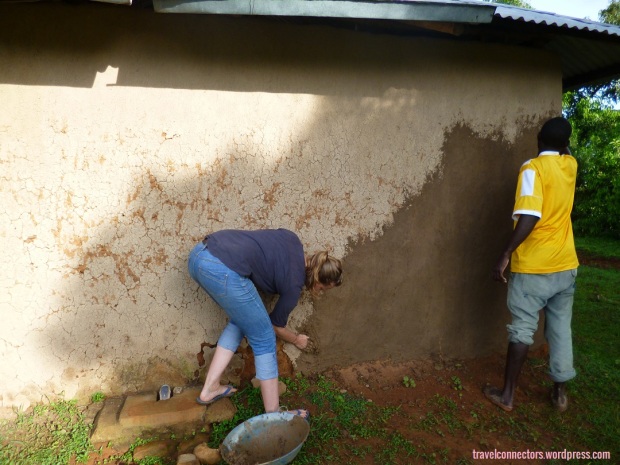or: How language carries stereotypes and racist ideas
My house in Kenya is situated on the countryside, close to the Ugandan border. It is built with a wooden structure filled and plastered with clay. It has a cemented floor and a veranda and the roof is made of iron sheets. I smoothened the walls myself, with a mixture of soil and cow dung. That’s probably the coolest natural material ever. Not only does it seal walls and baskets and smoothen front yards, it even keeps snakes away!
My house has two bedrooms, an inside shower, a large living room and glass windows. The high roof and the gap between the iron sheets and the walls prevent it from heating up too much even if the sun is really burning down on it. It’s basically air conditioned.

The living room. You can see the gap between roof and wall in the upper corner.*
My house is set on a family compound with the other houses of my in-laws (some grass-thatched, some with bricks and iron sheets), their kitchens, a kitchen garden, toilets, a cow shed, a house for chicken, an old granary and some small structures for ducks and dogs.

A house made of bricks that’s not yet finished, on the family’s compund.*
When I help my mother in law with cooking or farming, she tells me: “Take the food to the house.” or “Father is not in the house.” or “Put the hoe in front of the house.”
Whenever I show some pictures of these houses to friends and family in Germany, they call them huts.
And that hurts, because it feels like I don’t even own a proper, valuable, universally acknowledged place of shelter (that is, a house). Instead, I stay in some undervalued, not perfect, maybe even dirty or poor structure – a hut.
In my old travel diaries from my first vists to Kenya, I also called the buildings huts, although to their owners and inhabitants they are houses.

Houses? Or huts?*
That’s what I knew: Africans live in huts, right? Children’s books, teachers, movies and commercials tell us so. We go to the doctor, they go the medicine man. We have a mayor, they have a chief. We are organised in federal states, they in tribes and clans.
Let’s complicate the issue a bit more, shall we?
Kenyans actually use many of these words themselves. I learned from Kenyans that there are 42 tribes in Kenya, and everybody identifies with one. Imagine my surprise, when in my first semester of African Studies the lecturer told me that “tribes” and “chiefs” are a British colonial concept that is outdated and fiction and we shouldn’t use that term anymore? “But they say tribes themselves,” I revolted. I even met an assistant chief who introduced himself to me as such. It’s a political position.
But it’s also a word that carries values. A chief is not as competent as a mayor. Tribal conflicts are plain stupid and outdated. And a hut is not a proper house.
As travellers, we need to mind our language. Why don’t we name what we see in Africa in the same way we name things in our countries? Can we try and overcome the downgrading procedure of using colonial terms? It is very hard, but it opens our minds to constantly question our language and words.
Have you ever thought about the words you use? Share your experiences in the comments below!
(*Photos by my lovely sister.)
This free worksheet will help you when writing or talking about your trip to the global South. It has a language checklist reminding you of all the critical issues and a travel diary prompt to think beyond the common stereotypes and have a more awesome experience.
It is part of the free online course “My Conscious Trip to Africa” which you can join here.






Nice.. Please always notify me of any new articles or projects in your travel experience. But i am not actually agreeing with you that the word “Bandika” means Connect. According to my swahili understanding, it means “Sticking” or rather “Stick” like what you were doing when constructing the hut. That is sticking cowdung mixed with mud to build its wall. “Kubandika nyumba ukitumia matope”.
LikeLike
Thank you for the linguistic hint! We are currently working on a strategy of rebranding and redesigning name and logo. In that process the name might actually change. Thanks for the important input!
On the upper right side of the blog you can subscribe for all blog posts and more free stuff. Once we get seriously going this year, you won’t miss a thing if you are on that list. (And be assured that we treat your data personally and never give it out. We will just gratefully send you updates.)
LikeLike